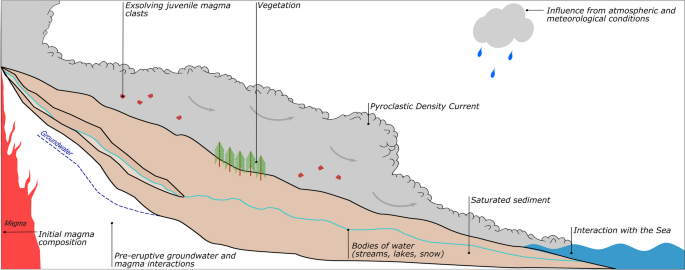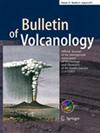火山碎屑物质的内聚行为及其对矿床结构的影响
IF 3.2
2区 地球科学
Q1 GEOSCIENCES, MULTIDISCIPLINARY
引用次数: 0
摘要
火山碎屑密度流(PDCs)是一种危险的多相非均质火山物质和气体流。水分(液体或气体)可以通过外部(例如与水体的相互作用)或内部(例如初始喷发活动类型)过程进入PDC,并且可以在不同的沉积层中记录水分的存在。我们使用模拟实验来探索从0.00% - 10.00% wt增加水分时火山碎屑材料的行为。我们的结果表明:(1)加入少量水分会改变火山碎屑材料的凝聚力,(2)少量增加水分会改变材料的性质,从自由流动的材料变成不流动的材料。(3)水分的变化会影响火山碎屑物质中气体逸出结构和流化剖面的形成;(4)气体流经沉积物会导致沉积物中的水分剖面和机械不均一性;(5)当水分驱动的黏性阻碍了气体逸出结构的生长时,压力会增加并以爆炸性的方式释放。这项工作强调了一套不同的气体逸出形态是如何在火山碎屑沉积物中形成的,这是由水分含量的非均质性引起的,解释了气体逸出结构的变化,并提供了二次爆炸的潜在机制。本文章由计算机程序翻译,如有差异,请以英文原文为准。

Cohesional behaviours in pyroclastic material and the implications for deposit architecture
Abstract Pyroclastic density currents (PDCs) are hazardous, multiphase currents of heterogeneous volcanic material and gas. Moisture (as liquid or gas) can enter a PDC through external (e.g., interaction with bodies of water) or internal (e.g., initial eruptive activity style) processes, and the presence of moisture can be recorded within distinct deposit layers. We use analogue experiments to explore the behaviour of pyroclastic material with increasing addition of moisture from 0.00–10.00% wt. Our results show that (1) the cohesivity of pyroclastic material changes with the addition of small amounts of moisture, (2) small increases in moisture content change the material properties from a free-flowing material to a non-flowable material, (3) changes in moisture can affect the formation of gas escape structures and fluidisation profiles in pyroclastic material, (4) gas flow through a deposit can lead to a moisture profile and resulting mechanical heterogeneity within the deposit and (5) where gas escape structure growth is hindered by cohesivity driven by moisture, pressure can increase and release in an explosive fashion. This work highlights how a suite of varied gas escape morphologies can form within pyroclastic deposits resulting from moisture content heterogeneity, explaining variation in gas escape structures as well as providing a potential mechanism for secondary explosions.
求助全文
通过发布文献求助,成功后即可免费获取论文全文。
去求助
来源期刊

Bulletin of Volcanology
地学-地球科学综合
CiteScore
6.40
自引率
20.00%
发文量
89
审稿时长
4-8 weeks
期刊介绍:
Bulletin of Volcanology was founded in 1922, as Bulletin Volcanologique, and is the official journal of the International Association of Volcanology and Chemistry of the Earth’s Interior (IAVCEI). The Bulletin of Volcanology publishes papers on volcanoes, their products, their eruptive behavior, and their hazards. Papers aimed at understanding the deeper structure of volcanoes, and the evolution of magmatic systems using geochemical, petrological, and geophysical techniques are also published. Material is published in four sections: Review Articles; Research Articles; Short Scientific Communications; and a Forum that provides for discussion of controversial issues and for comment and reply on previously published Articles and Communications.
 求助内容:
求助内容: 应助结果提醒方式:
应助结果提醒方式:


